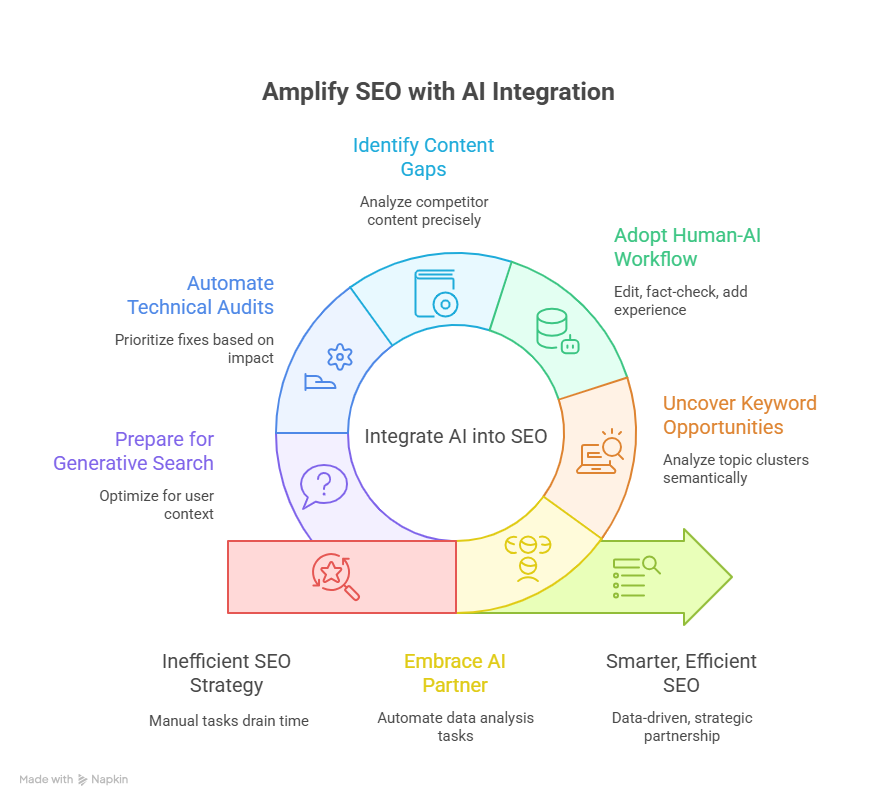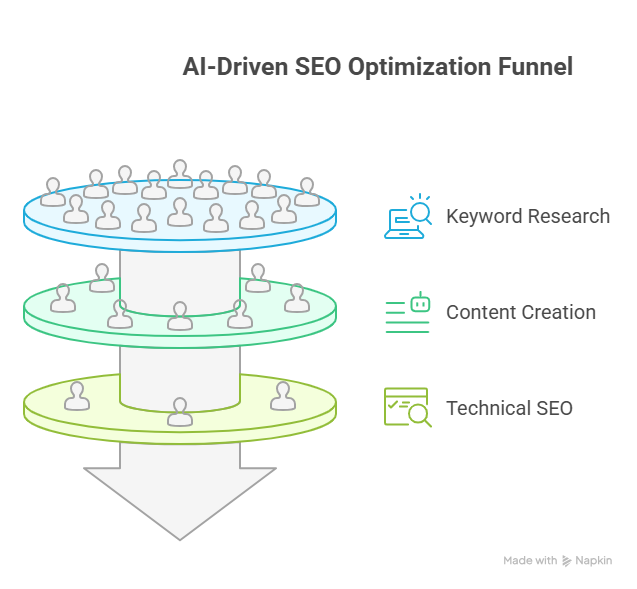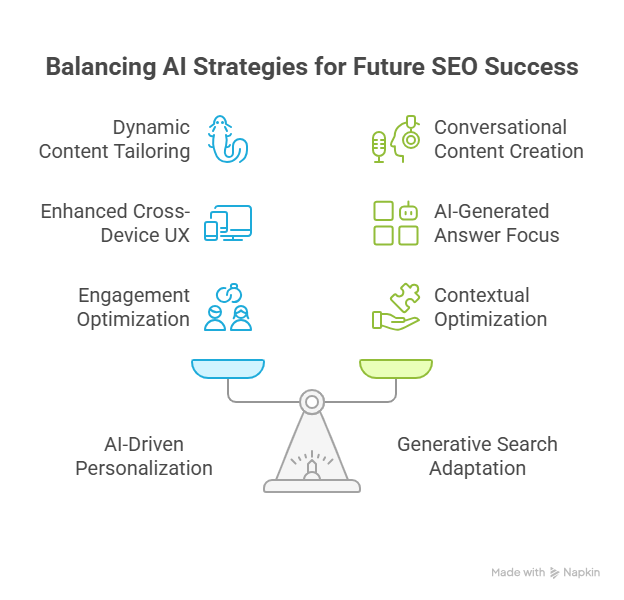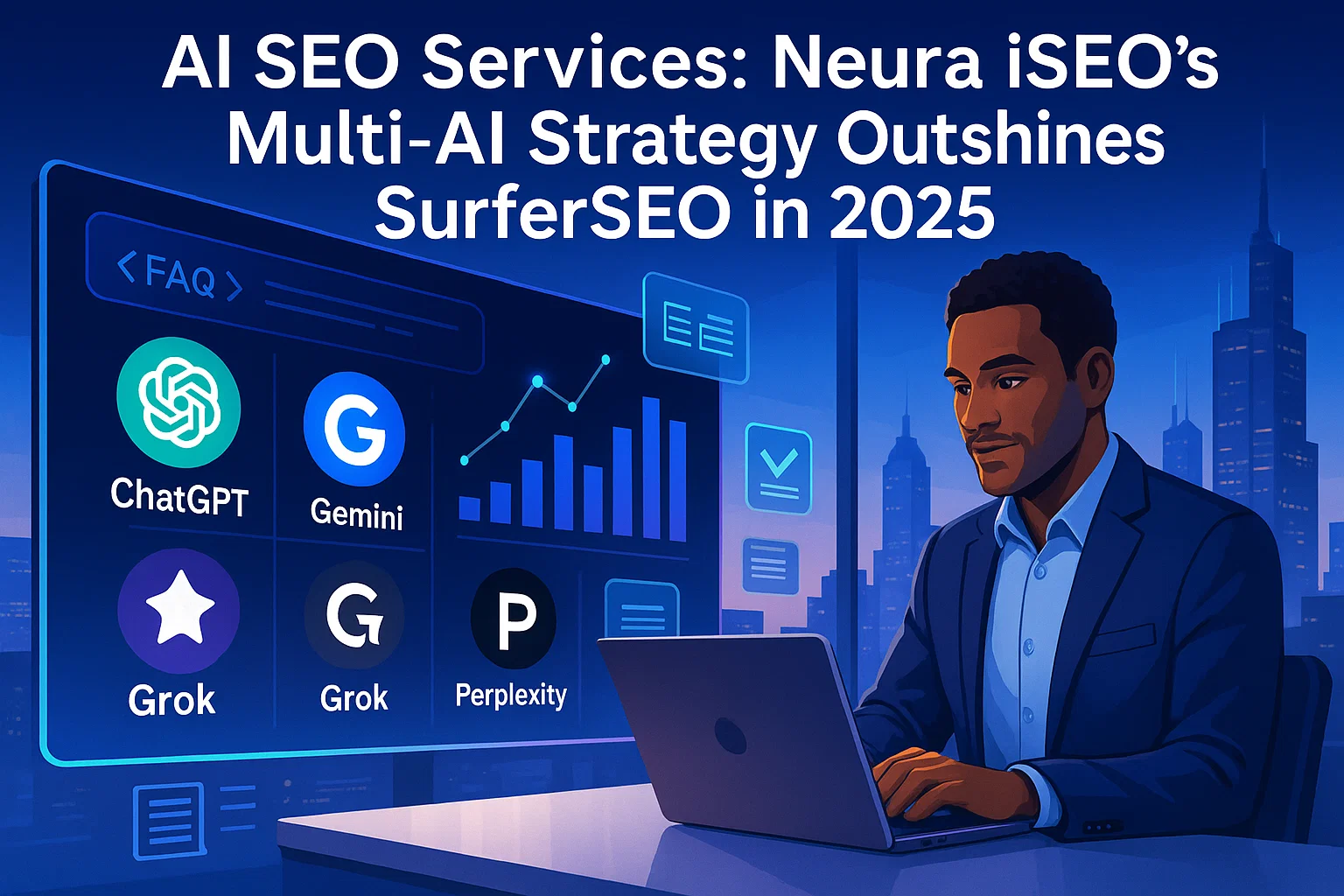Master AI SEO Strategies: How to Use AI for SEO Effectively
Key Takeaways
Integrating AI into your SEO isn’t just about new tools; it’s a fundamental shift toward a smarter, more efficient strategy. While the full article provides a deep dive into implementation, these are the most critical insights you can use to start amplifying your search performance today.
- Embrace AI as a strategic partner, not a replacement for human expertise. It automates tedious data analysis, freeing you to focus on high-level creativity and complex strategy.
- Uncover hidden keyword opportunities by using AI to analyze topic clusters and semantic variations. This allows you to build true topical authority and rank for dozens of related terms simultaneously.
- Adopt a human-AI content workflow for maximum efficiency without sacrificing quality. Use AI for drafting and ideation, but always have a human expert edit, fact-check, and add unique experience to meet E-E-A-T standards.
- Identify competitor content gaps with precision. AI analyzes top-ranking pages to reveal the subtopics and user questions your competitors have overlooked or failed to cover well.
- Automate technical SEO audits that find patterns, not just errors. AI-powered tools can identify the root cause of issues and help you prioritize fixes based on their potential impact on your traffic and rankings.
- Prepare for generative search (SGE) by creating content that provides clear, direct answers. The focus is shifting from keywords to optimizing for underlying user context and intent.
Dive into the full guide to see detailed examples and workflows for putting these powerful AI strategies into action.
Introduction
Staring at another keyword spreadsheet, wondering if you’ve missed a critical opportunity? We’ve all been there—buried in manual tasks that drain time and deliver uncertain results.
The truth is, modern search engines are already built on sophisticated AI. To win in search today, you need to speak their language. Integrating AI into your SEO isn’t about chasing a trend; it’s a competitive necessity.
This isn’t about replacing your strategic expertise. It’s about amplifying it—giving your best analyst the power of a thousand-person research team to find patterns and opportunities hidden in plain sight.
This guide moves beyond the hype to give you a practical, actionable playbook. We’re breaking down exactly how to use AI to get measurable results, helping you:
- Turn keyword research from a guessing game into a predictive science.
- Create and optimize high-quality content faster with a human-led workflow.
- Automate complex technical SEO audits and on-page fixes at scale.
- Prepare your strategy for the next wave of search, including Google SGE.
Forget thinking of AI as just another tool on the list. It’s time to see it as your new strategic partner for building a smarter, faster, and more dominant SEO presence.
Understanding the AI Revolution in SEO
The arrival of AI in SEO isn’t just about new tools. It represents a fundamental shift in how we build a search strategy, moving from tedious manual work to an intelligent, data-driven partnership.
This isn’t about replacing human expertise; it’s about amplifying it.
From Manual Tasks to Strategic Partnership
Think of the old way of doing SEO: endless spreadsheets for keyword tracking and slow, line-by-line content audits. The AI-powered approach automates this heavy lifting.
Imagine giving your best analyst a research team of a thousand. That’s AI. It processes enormous amounts of data, freeing you to focus on creativity and complex problem-solving. This is possible because of two core concepts:
- Machine Learning (ML): Identifies subtle patterns and predicts trends in search data that a human could never spot.
- Natural Language Processing (NLP): Understands the intent and context behind a search query, not just the keywords used.

Why AI is No Longer Optional
Integrating AI is now a competitive necessity. Search engines like Google are built on AI, so using these tools means you finally speak the same language.
Modern SEO runs on a deluge of data—user behavior signals, competitor ranking shifts, and constant SERP updates. AI is the only practical way to analyze this volume of information and find actionable insights.
This technology also democratizes the playing field. AI gives smaller businesses and solo marketers the analytical power that was once reserved for large enterprises, allowing them to compete on strategy, not just budget.
AI doesn’t replace the strategist; it makes them smarter, faster, and more effective. It handles the «what» so you can focus on the «why» and «how» to win in search.
Pillar 1: AI-Powered Keyword Research and Content Strategy
Let’s get practical. The foundation of great SEO is understanding what people are searching for, and AI transforms this from a guessing game into a predictive science.
It’s about moving beyond obvious keywords to find the hidden opportunities that drive real traffic and build your authority.
Uncovering Hidden Keyword Opportunities
Manual research often gets stuck on broad «head terms.» AI tools dig deeper, using natural language processing to unearth a goldmine of related queries that signal strong user intent.
This is where you gain a competitive edge. AI identifies:
- Long-tail keywords: Hyper-specific phrases your ideal customers use.
- Semantic variations: Different ways users talk about the same topic.
- Question-based queries: The exact questions your audience is typing into Google.
But it’s not just about finding more keywords—it’s about finding the right ones. Predictive keyword analysis forecasts the potential traffic and conversion value of terms, so you can prioritize efforts for the highest ROI.
Clustering for Topical Authority
Instead of targeting one-off keywords, AI groups hundreds of related queries into «topic clusters.»
This process allows you to build comprehensive pillar pages that cover a subject in-depth. By creating content that addresses an entire cluster, you signal to Google that you are an authority on that topic, making it easier to rank for dozens of related terms simultaneously.
Picture this: AI analyzes the top 20 results for your main topic and instantly deconstructs what makes them successful, from common themes to average word counts.
AI-Driven Competitor Analysis
This same analysis also reveals what your competitors are missing. AI is brilliant at identifying «content gaps»—subtopics they’ve overlooked or haven’t covered well.
This gives you a clear roadmap to creating content that is objectively more comprehensive and valuable than what currently ranks. AI can also analyze SERP features like «People Also Ask» boxes and Featured Snippets, telling you exactly what content formats are winning.
Ultimately, AI-powered research provides a data-backed blueprint for your content strategy. You move from guessing what might work to knowing exactly what topics to cover, how to structure your articles, and where the clearest opportunities to outrank your competition lie.
Pillar 2: Revolutionizing Content Creation and Optimization
This is where AI in SEO gets the most attention: content.
Let’s cut through the noise. The goal is to leverage generative AI for efficiency while upholding the high standards of quality, originality, and authority that Google demands.
The Human-AI Content Workflow
Think of AI as the ultimate brainstorming partner. It provides the raw clay, but the human is always the sculptor.
This partnership allows you to supercharge your entire content process:
- Ideation and Drafting: Use AI to generate comprehensive outlines, explore unique angles, and create initial drafts in minutes, not hours.
- Optimizing Existing Content: This is a powerful, low-risk strategy. Feed AI your underperforming blog posts to identify opportunities for adding new keywords, improving readability, and updating for freshness.
- Automating SEO Metadata: For large sites with thousands of pages, AI is a lifesaver. It can generate compelling and keyword-rich meta titles, descriptions, and image alt text at scale.
Maintaining Authenticity and E-E-A-T
Here’s the most important rule of AI-assisted content: human oversight is non-negotiable. Every word must be fact-checked, edited for brand voice, and enhanced with unique human experience and perspective.
To build trust and align with Google’s E-E-A-T guidelines (Experience, Expertise, Authoritativeness, and Trust), you must manually enhance the output.
- Incorporate original data or unique case studies.
- Add authentic author bios and expert quotes.
- Cite credible, primary sources to back up all claims.
Avoiding Google’s Spam Policies
It’s critical to understand the difference between using AI as a tool versus a content mill.
Google has made it clear that using AI to create helpful, people-first content is acceptable. What violates its spam policies is generating low-quality, unoriginal content at scale purely for ranking manipulation. Always prioritize genuine value over sheer volume.
Ultimately, AI doesn’t replace the need for a great content strategy. It empowers it, allowing you to produce higher-quality, better-optimized content faster than ever—as long as a human expert is guiding the entire process.
Pillar 3: Automating Technical SEO and On-Page Excellence
Technical SEO can feel like a daunting, never-ending checklist. It’s where many strategies stall, buried under complex issues and manual fixes.
AI transforms this critical discipline from a reactive chore into a streamlined, intelligent system. It makes high-level technical optimization accessible to everyone, not just developers.
Conducting Intelligent Site Audits
Traditional site crawlers find errors. AI-powered crawlers find patterns.
Instead of just giving you a list of 404 errors, an AI system identifies why they’re happening. This shifts your focus from tedious manual checks to proactive problem-solving. AI can even prioritize fixes based on their potential impact on traffic, so you’re always working on what matters most.
Key areas where AI excels in auditing include:
- Crawlability & Indexability: Automatically finding and flagging orphan pages, incorrect noindex tags, and crawl budget waste.
- Site Speed: Analyzing Core Web Vitals and providing specific, actionable code and asset recommendations.
- Schema Markup: Identifying pages that could benefit from structured data to earn rich snippets in search results.
Scaling On-Page Optimization and Linking
Imagine needing to update meta descriptions on 1,000 product pages. AI turns that month-long project into an afternoon task.
This ability to implement bulk fixes is a massive advantage. But AI’s real power lies in building a strategic internal linking structure. It analyzes your entire site to suggest contextually relevant internal links, helping distribute authority and guide users and search engines to your most important content.
Monitoring for Lasting Health
Your site’s technical health isn’t a one-time fix. AI acts as a vigilant watchdog.
You can set up systems to continuously monitor your site’s health and send instant alerts for critical issues like a sudden drop in page speed or new indexing errors. This allows you to respond immediately—before a minor glitch can impact your rankings.
By automating technical audits, on-page fixes, and monitoring, AI handles the heavy lifting. This frees you up to focus on the high-level strategy that drives real growth.

Advanced Strategies: Personalization and Adapting to New Search Paradigms
The world of search is evolving far beyond ten blue links. This is where we look ahead, using AI to prepare for a future driven by personalized experiences and new search interfaces like Google’s SGE.
Winning in modern SEO means creating dynamic, user-centric experiences. AI is the engine that makes this possible at scale, turning static websites into responsive, intelligent platforms.
AI-Driven Personalization and User Experience (UX)
Imagine your website automatically adapting to each visitor. AI analyzes user data in real-time to personalize the content they see, boosting engagement and conversions.
This goes beyond just a name in an email. AI tools can:
- Tailor Content Dynamically: Showcase different products or articles based on a user’s location, browsing history, or past purchases.
- Optimize for Engagement: Interpret signals like dwell time and scroll depth to provide actionable advice on improving page layouts and calls-to-action.
- Enhance Cross-Device Experience: Analyze site performance on mobile, tablet, and desktop to ensure a seamless experience for every user.
Preparing for Generative Search and Voice
With tools like Google SGE, the goal is shifting from simply ranking #1 to being part of the AI-generated answer.
Your strategy must adapt. Focus on creating content that is easily digestible for AI, using conversational language and providing clear, direct answers to common questions. This is also key for voice search, where queries are longer and more question-based. AI helps you find these conversational queries and structure your content accordingly.
Context is the New Keyword
The future of search is less about specific keywords and more about the underlying context and intent. Why is the user searching for this? What problem are they trying to solve?
AI excels at deciphering this intent from massive datasets. It allows you to optimize for the underlying context of a search, ensuring your content is the most relevant answer, no matter how a user phrases their query.
Using AI to anticipate user needs and adapt to new search paradigms is no longer just an advanced tactic—it’s essential for building a resilient SEO strategy that thrives in the future.

Conclusion
Integrating AI into your SEO isn’t just about adopting new tools—it’s about fundamentally upgrading your strategic capabilities. You’re moving from manual guesswork to an intelligent partnership that amplifies your expertise.
This shift allows you to focus on what truly matters: high-level strategy, creativity, and building genuine authority.
Here are the key actions to focus on as you start:
- Uncover Hidden Opportunities: Use AI to move beyond surface-level keywords and identify the specific, high-intent questions your audience is asking.
- Adopt the Human-AI Workflow: Leverage AI for efficient drafting and data analysis, but always be the one to infuse unique experience, facts, and brand voice.
- Automate Technical Health: Set up AI-powered audits to continuously monitor your site, freeing you to solve strategic problems instead of just fixing errors.
Your first step doesn’t have to be massive. Choose one of your underperforming articles this week and use an AI tool to identify content gaps and optimization opportunities. This single, practical action will reveal the immediate power of this new approach.
The future of search won’t be won by AI alone, but by the strategists who master it. It’s your human intuition, amplified by machine intelligence, that will create the next generation of winning SEO.

